In the Sikshavalli section of Taittriyopanishad, there is a manthram passage known as “LakshmyAdhi PrArTanaa”:
“Aavahanthee vithanvanaa, kurvANaa cheeramAthmana,
VaasAmsi mama gAvasccha, annapAnE cha sarvadhaa,
tathO mE SriyamAvaha, lOmaSAm Pasubhi: saha svAhaa”
This is a prayer to Sri Devi for the conferral of many kinds of auspiciousness and wealth. It says: (As You are) the generator and the multiplier of wealth, May Thou always bless me (the BrahmachAri) “with bark garments, clothes and cattle, food and drink; produce for me wealth along with plenty of materials like animals (for performance of Yaj~nams), Svaahaa”.
This is the prayer of BrahmachAri engaged in the acquisition of knowledge Vedic wisdom) at the feet of a Sadhaacharyan and ready to enter GrahasthAsramam. In this prayer of “Sriyam aavaha” to Sri Devi, the BrahmachAri prays for the acquisition of the wealth in the form of the 3 Vedaas. Sriyam (the wealth) is defined as “thrayee lakshaNam”. This type of wealth in the form of the three Vedaas is considered as “the immortal wealth of the virtuous (“saa hi Sriramruthaa sathaam”).
The SadhaachAryan prays to Sri Devi as well: “Aaa maa yanthu BrahmachAriNa: svAhaa” (May Brahmachaaris / sishyaas come to me from all directions!)…. “SrEyAn vasyasOasaani svAhaa” (May I become the most praiseworthy among the wealthy/the possessors of Vedic knowledge).
The joint prayer by AchAryan and the sishyan now is: “prathivEsOasi pra maa Paahi pra maa Padhysava” (Oh Supreme One! You are very near to me. Protect me securely. Make me a surrenderer / prapannan). “PrathivEsa” means, “Thou art near me”. “Prapadhyasva” means make me a Prapannan (Prapannam maam kuru). Lakshmi Prapatthi is done here.
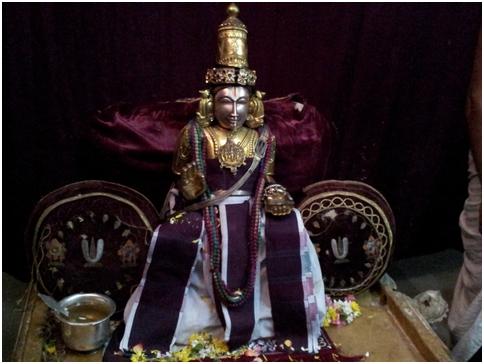
One day a poor Brahmachari, who had completed VedAdhyayanam arrived at VedanthaachAryan’s house at Thuppul. He prostrated before Swamy Desikan and explained his predicament in not being successful in gaining the hand of a suitable bride because of his poverty. The most compassionate VedAnthAchAryan took the Brahmachari to the Sannidhi of PerumdEvi ThaayAr, the divine consort of Lord Varadarajan and composed a sthuthi on this archaa Moorthy of Sri Devi to recieve Her anugraham for the Brahmachaari. The rest is history. At the conclusion of the recitation of this new sthuthi for Sri Devi rich in VedAnthic meanings and deep devotion for the anugrahamayee, a rain of gold coins poured in front of Swamy Desikan. The Brahmachaari collected the coins, offered his vandhanams to Swamy Desikan and PerumdEvi ThaayAr and found a suitable bride to enter grahasthaasramam. The parama vairAgyasaali, Swamy Desikan went home and continued with his dinacharyaa.
This monograph has been prepared as a humble offering at the sacred feet of asmath AchAryan, Veda Maarga PrathishtApanAcharya, Sri Bhagavath RaamAnuja SiddhAntha nirdhAraNa Saarvabhouma Sri NaarAyaNa Yatheendhra MahA Desikan, Prakrutham Azhagiya Singar of the illustrious Peetam of Sri Matam during the occasion of His forthcoming 79th Thirunakshathram to be celebrated at Bangalore on December 10, 2005. On behalf of all the sishyAs and abhimAnis of Sri Matam, adiyEn prays to MahA Lakshmi and MalOlan for the showering of Kanaka dhAraa on our revered Jeeyar for continuation of His MahA Kaimkaryams to the PaadhukAs of MalOlan.
adiyEn takes this opportunity to reflect on another section of the Siksha Valli of TaittiriyOpanshad (anthEvAsyAnuSAsanam), which starts with “VedamanUchAchAryO anthEvAsinam anuSAsthi” and ends with “Maathru dEvO bhava, Pithru DevO bhava, AachArya devO bhava, athiTi dEvO bhava”. Dr. N.S. Anantharangachar Swamy has translated the full text of this command and instruction of the AchAryan to His sishyan this way:
“Having taught the VedAs, the teacher should instruct the disciple thus; Speak the truth. Practise righteousness. Make no mistake about study of the Veda. Having offered the preceptor the desired wealth, do not cut off the line of progeny. You should not be inadvertent about the truth. There should be no faltering from Dharma. There should not be inadvertence regarding the performance of auspicious deeds. You should not be indifferent towards activities for wealth. You should not be careless about the learning and teaching of the Vedas. You should not be inadvertent about your duties towards the Gods and the manes. Be one for whom the Mother is a Goddess. Be one for whom the father is a God. Let your Acharyan be a God unto you. Let Your guest be a God unto you ……” This is the command and this is the instruction. This is the secret teaching of the Veda. This is the command that the teacher should impart to the disciple. Thus should it be practised. Thus alone should one meditate (…yEsha AadESa:, yEsha upadESa:, yEshA vEdOpanishad, yEtadhanuSaasanam, yEvam upAsithavyam, yEvamuchaitadhupAsyam).
There are many sthOthrams in praise of our Supreme Mother. ChathusslOki of Swamy AlavanthAr, Sri Sthavam of Swamy KurEsar and Sri Sthuthi of Swamy Desikan besides Sri Lakshmi Sahasram by Sri VenkatAdhri Kavi, Lakshmi AshtOttharam and Sahasra Naamam.
Sri Sthuthi of Swamy Desikan has 25 beautiful and powerful slOkams that on recitation confers Sarva MangaLams (Ishta Kaamya Siddhi) to the reciter.
The Poetic Metre of SrI Sthuthi SlOkams:
Swamy Desikan has set the First 24 of the 25 slOkams of Sri Sthuthi in the MandhAkrAntha Metre and the 25th slOkam in the Maalini metre. It is striking to note that Swamy Desikan chose the same MandhAkranthA metre for the 24 Sri Sthuthi SlOkams that he elected for eulogizing the Lord of Srirangam in the 12 slOkams of Sri Bhagavath DhyAna sOpAanam; latter is modelled after ThiruppANAzhwAr’s dhivya Prabhandham of AmalanAdhipirAn, which is an exquisite anubhavam of the soundharyam of the Lord’s ThirumEni from His sacred feet to His majestic crown.
Sri Sthuthi and PattAbhishEkam for Sri Devi as Sarva lOka Iswari:
In a similar vein, Swamy Desikan praises the glories of Sri Devi in the first 12 and the last twelve slOkas and right smack in the middle (13th sLokam) positions a gem of an anubhavam of the PattAbhishEkam of Sri Devi as Sarva Loka Iswari as described in Sri VishNu PurANam according to Vaikunta Vaasi Sri V.N.SrirAma DesikAcchAr Swamy of Oppiliappan Sannidhi.
Six Topics Celebrated in Sri Sthuthi:
Sri Devi’s Svaroopam, ThirumEni Soundharyam, KalyANa guNams, Vibahavam, Archai and Iswaryam are celebrated in these 25 slOkams.
Her Three ArchA Forms:
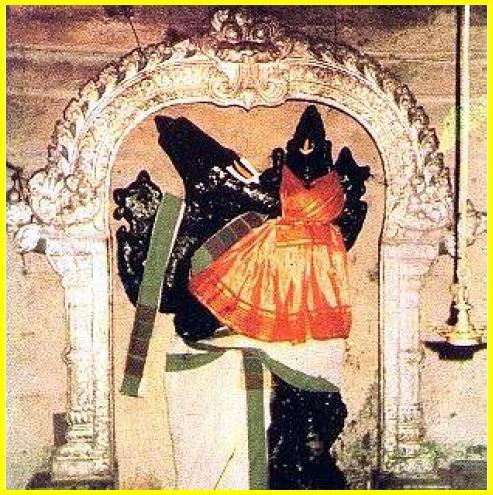
As LayArchA Moorthy, She takes Her place on the sacred chest of the Lord and never ever leaves Him. There She stays as the Empress of the Lord and pleads for Her Lord’s forgivance of the multitudinous trespasses of the chEtanams (PurushakAram role); next, She stays as the Means (UpAyam) along with Her Lord during ChEtanan’s Prapatthi and as Phalan for Moksham that arises as a result of the Prapatthi performed.
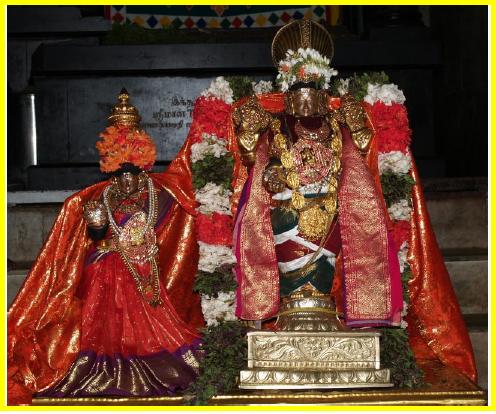
As BhOga ArchA Moorthy, She stays by Her Lord’s side.
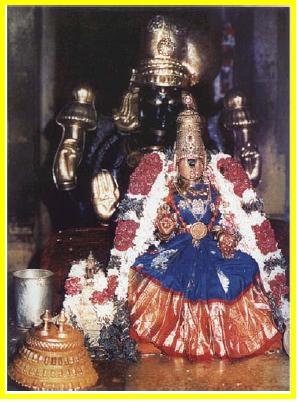
As AdhikAra ArchA Moorthy, She stays at Her separate Temple (Sannidhi) without Her Lord.
The Kaamya Siddhi from reciting Individual slOkams of SrI Sthuthi:
Each Of the 25 slOkams have their own power to grant specific wishes. Scholars have summed up the power of these individual slOkams this way in the AhObila Mata SampradhAyam:
1st SlOkam: MaanAtheetha — For rise of all MangaLams
2nd SlOkam: AavirbhAva: —- For gaining control over divine speech
3rd SlOkam: SthOthavyathvam —- For fulfilment of what one desires
4th SlOkam: Yath Sankalpath —- For the enrichment of one’s DhyAnam
5th SlOkam: NishprathyUha — For growth in VedAntha VidhyA
6th SlOkam: UddhEsyathvam— For enhancing happiness of the Mind
7th SlOkam: Pasyantheeshu — For landing high positions
8th SlOkam: AsyEsAnaa—For destruction of One’s sins
9th SlOkam: ThvAmEvAhu: — For enhanced recognition of one’s name/Fame
10th SlOkam: AapannArTi —-For destruction of one’s sorrows and fears
11th SlOkam: DhatthE SObhAm — for gaining Her Lord’s anugraham
12th SlOkam: AasamsAram — For the blessings of a distinguished Education
13th SlOkam: AgrE Bharthu: — for the fulfilment of Subha Kaaryams
14th SlOkam: AalOkyathvAm — For neutralization of Curses
15th SlOkam: AarthathrANa — For gaining everlasting wealth
16th SlOkam: yOgArambha —- For the growth of one’s Bhakthi
17th SlOkam: SrEyaskAmA: —For attaining High Positions
18th SlOkam: Ureekarthum —For conquering the vagaries of one’s mind
19th SlOkam: JaathAkAnkshA — For attachment to Dharmam
20th SlOkam: sEvE Devi! — For gaining Moksham
21st SlOkam: sAnuprAsa — For destruction of physical/mental illnesses
22nd SlOkam: SampadhyanthE — For removal of fears about SamsAram
23rd SlOkam: MaathA Devi! — For gaining Kaimkaryams (Kaimkarya PrApthi)
24th SlOkam: KalyANAnAm — For gaining all desired Phalans
25th SlOkam: Upachitha Guru BhakthE: — For growth in AchArya Bhakthi
The Sankalpam for each of the slOkams for specific siddhi has to be followed by:
SrImAn VenkatanATArya: KavitArkika Kesaree
VedAnthAchAryavaryO mE sannidhatthAm sadhA hrudhi
the SlOkam or the whole Sthuthi should be recited now.
The Japam should be completed with:
KavitArkika Simhasya KalyANaguNasAlinE
SrImathE VenkatEsAya VedAntha GuravE nama:
To be continued…
Source:


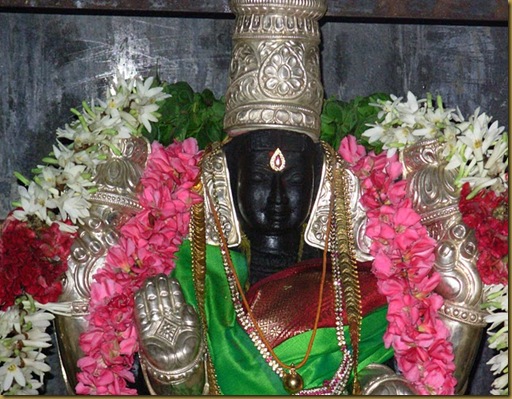







wealth of information required by prapannas. Simplified for us lesser mortals! Thank you.can we know the meaning of Lakshmi ashtothram starting prakruthyai namaha?